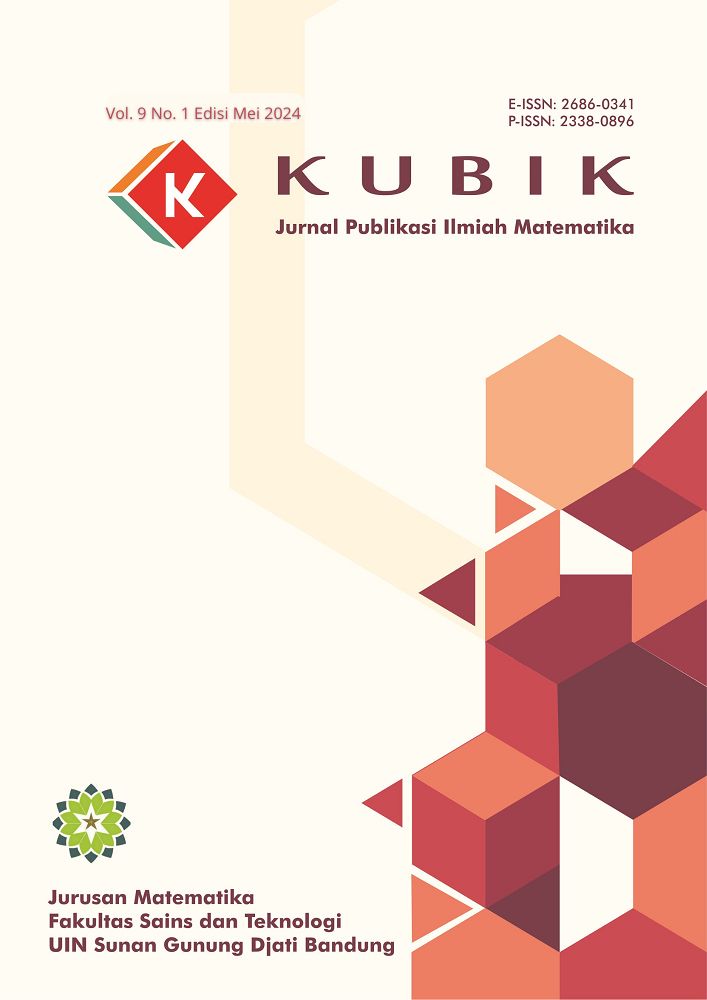Panel Data Analysis of Two Level Mixed Linear Models for Factors Affecting The Health Index in West Java
DOI:
https://doi.org/10.15575/kubik.v9i1.31369Keywords:
Panel Data, Mixed Linear Models, Maximum Likelihood (ML), Restricted Maximum Likelihood (REML), Health DataAbstract
The purpose of this study is to construct a multilevel mixed linear model for panel data by estimating parameters and testing the hypothesis of fit of the model with case studies in determining the prediction of the health index for the marginal and conditional models on the factors that influence the prediction of the health index in West Java for 2016 data. -2021, with time (year) and region (district and city) variables as factors involved in the model. Multilevel mixed linear model is the development of a mixed linear model that can be used to analyze correlated panel data. Parameter estimation uses the Maximum Likelihood (ML) method to estimate fixed effect parameters and Restricted Maximum Likelihood (REML) to estimate covariance parameters. The results obtained by the health index prediction model in West Java, both for the marginal and conditional prediction models and goodness of fit model.
References
E. W. Frees, "Longitudinal and Panel Data Analysis and Applications" In The Social Sciences. New York: Cambridge University Press, 2004.
C. Angelini, "Regression analysis", Vol. 1–3. Elsevier Ltd., 2018.
N. Pandis, “Cross-sectional studies,â€Am. J. Orthod. Dentofac. Orthops., vol. 146, no. 1, pp. 127–129, 2014.
S. Searle, G. Casella, and C. McCulloh,"Variance Components", New Jersey: A John Wiley & Sons, Inc., 2006.
N. H. Pusponegoro, R. N. Rachmawati, K. A. Notodiputro and B. Sartono, “Linear Mixed Model for Analyzing Longitudinal Data: A Simulation Study of Children Growth Differencesâ€, Procedia Comput. sci., Vol. 116, pp. 284–291, 2017.
S. Ross, "Introduction to Probability and Statistics for Engineers and Scientists", Sixth Edit. London: Katey Birtcher, 2021.
H. Liu, Y. Zheng, and J. Shen, “Goodness-of-fit measures of R2 for repeated measures mixed effect models,â€J. Appl. Stats., Vol. 35, No. 10, pp. 1081–1092, 2008.
A. C. Rencher and G. B. Schaalje, "Linear Models in Statistics", Second Edition, Vol. 84, No. 500, New Jersey: John Wiley & Sons, Inc., 2000.
F. N. Gumedze and T. T. Dunne, “Parameter estimation and inference in the linear mixed modelâ€, Linear Algebra Appl., Vol. 435, No. 8, pp. 1920–1944, 2011.
X. Liu, "Methods and applications of longitudinal data analysis", Elsevier Inc., 2015.
J. Hilbe and A. Robinson, "Methods of Statistical Model Estimation", Boca Raton: CRC Press, 2013.
B. West, K. Welch, and A. Gałecki, "Linear Mixed Models A Practical Guide Using Statistical Software", Second Edition, vol. 53, no. 9, Boca Raton: CRC Press, 2015.
B. West, K. Welch, and A. Gałecki, "Linear Mixed Models A Practical Guide Using Statistical Software", Second. Boca Raton: CRC Press, 2015.
J. W. Wu, "The Quasi-Likelihood Estimation In Regression", Ann. Inst. Statist. Math., Vol. 48, No. 2, pp. 283-294, 1996.
P. Widyaningsih, DRS. Saputro and A.N. Putri, "Fisher Scoring Method for Parameter Estimation of Geographically Weighted Ordinal Logistic Regression (GWOLR) Mode", Journal of Physics: Conf. Series, Vol. 855, No.1, p. 012060 2017.
B. P. Carlin and T. A. Louis, "Bayes and Empirical Bayes Methods for Data Analysis, Second Edition", Boca Raton: CRC Press, 2000.
N. Saputri, B. N. Ruchjana and E. S. Hasbullah, "Penerapan Model Regresi Data Panel pada Faktor Fundamental dan Teknikal Harga Saham Sektor Industri Real Estate", Kubik: Jurnal Publikasi Ilmiah Matematika, Vol. 5, No. 1, pp. 10-19, 2020.
R. Rahmadeni, and N. Nurjannah, "Model Tingkat Kemiskinan di Kabupaten/Kota Provinsi Riau: Menggunakan Regresi Data Panel", KUBIK: Jurnal Publikasi Ilmiah Matematika, Vol.6, No. 2, pp. 98-109, 2021.
D. F. Durrah, R. Cahyandari and A. S. Awalluddin, "Model regresi data panel terbaik untuk faktor penentu laba neto perusahaan asuransi umum Syariah di Indonesia", KUBIK: Jurnal Publikasi Ilmiah Matematika, Vol.5, No. 1, p. 27-34, 2020.
Downloads
Published
How to Cite
Issue
Section
Citation Check
License
Authors who publish in KUBIK: Jurnal Publikasi Ilmiah Matematika agree to the following terms:
- Authors retain copyright and grant the journal right of first publication with the work simultaneously licensed under a Attribution-ShareAlike 4.0 International (CC BY-SA 4.0) License that allows others to share the work with an acknowledgment of the work's authorship and initial publication in this journal.
- Authors are able to enter into separate, additional contractual arrangements for the non-exclusive distribution of the journal's published version of the work (e.g., post it to an institutional repository or publish it in a book), with an acknowledgment of its initial publication in this journal.
- Authors are permitted and encouraged to post their work online (e.g., in institutional repositories or on their website) prior to and during the submission process, as it can lead to productive exchanges, as well as earlier and greater citation of published work (See The Effect of Open Access).
Â









